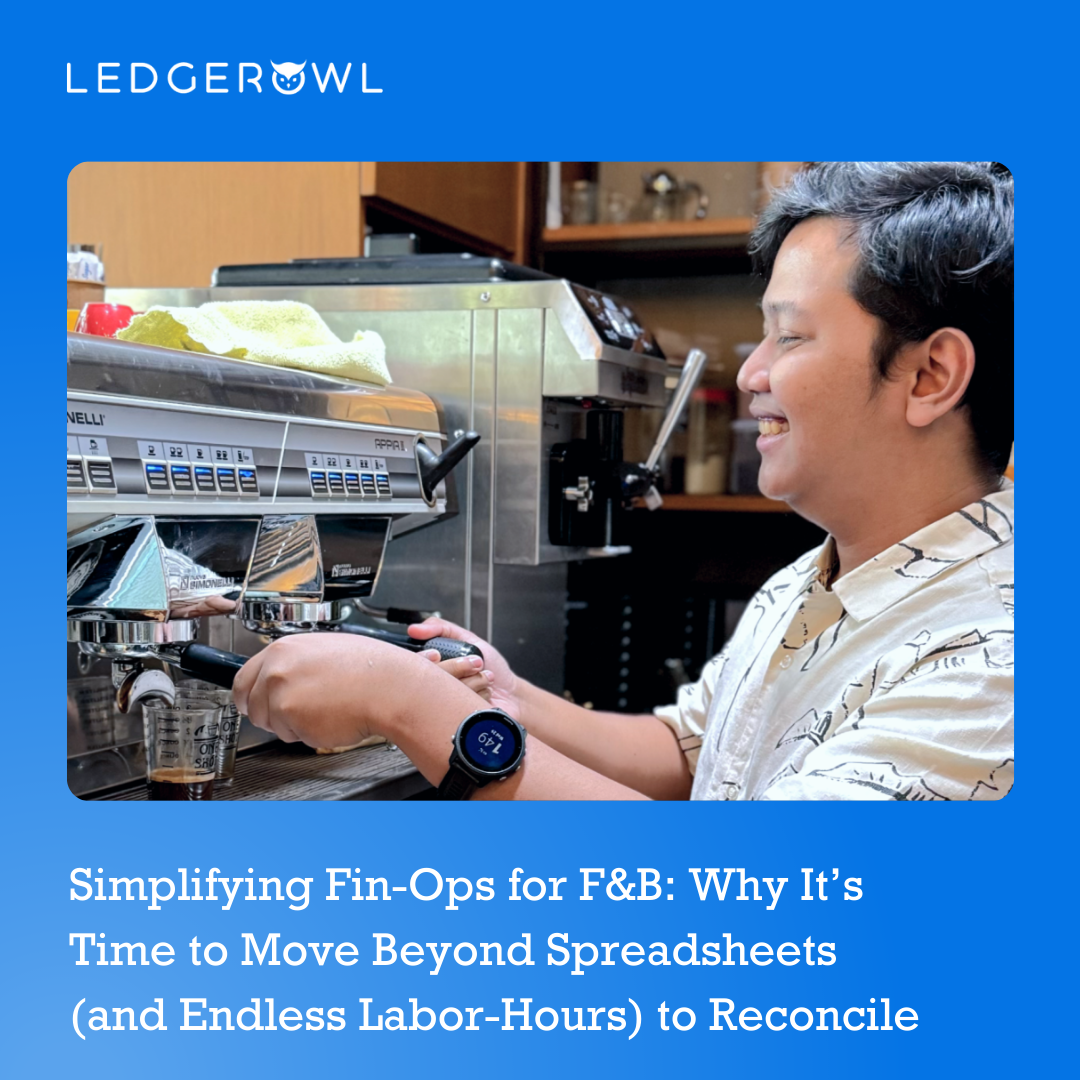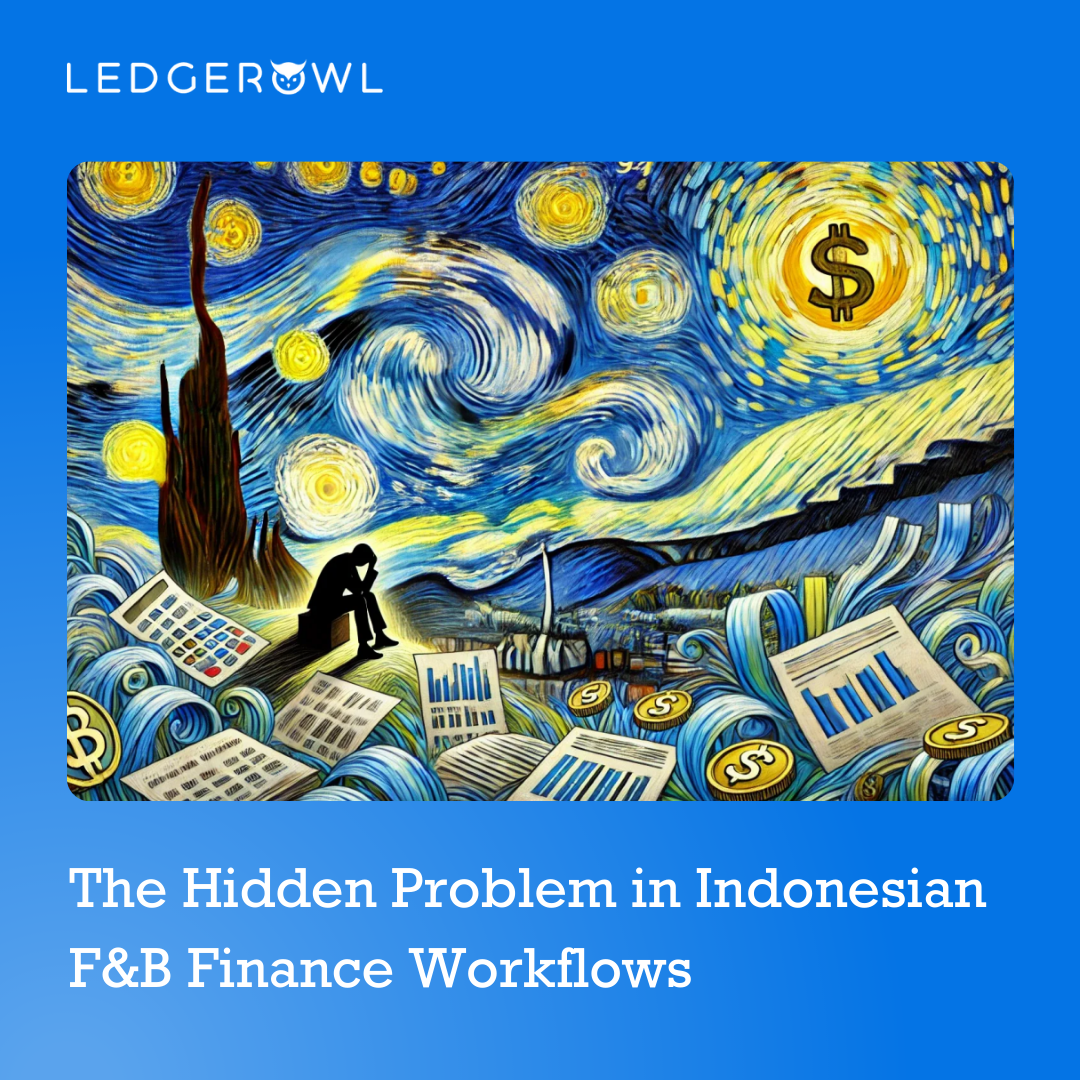In Indonesia, the food and beverage F&B industry is a lifeblood of our economy, growing rapidly and thriving at every level—from the small, local warungs to high-end restaurants and café chains. But as these businesses expand, opening more locations and offering more payment methods, the financial side of running a business becomes increasingly complex. As someone who closely connected to this space, you’ve likely felt the pressure of managing not just the food, but also the constant financial operations that come with handling so many moving parts.
With digital payments taking off and the push to offer omni-channel sales experiences, the task of tracking transactions is becoming a true headache. If you run multiple locations, you’re likely juggling payments from everywhere—cash at your physical stores, digital payments like GoPay, OVO, and ShopeePay, not to mention credit cards, bank transfers, and third-party food delivery platforms. And all of this falls on your finance team to somehow make sense of it all. The complexity is overwhelming, and trying to reconcile these payments at the end of the day is turning into a nightmare.
What is Reconciliation Process for F&B Businesses?
In F&B businesses, the reconciliation process is all about making sure that the financial records from various systems actually match up. Whether it’s sales from your POS system, payments made through digital wallets like GoPay or OVO, or orders from delivery apps like GrabFood or GoFood, everything needs to align perfectly. It’s that moment when you need to make sure what you’ve sold and what you’ve been paid for line up without any surprises.
When you’re running multiple locations with a mix of payment methods, the reconciliation process becomes even more critical. It’s what keeps your financial records in check, making sure everything is accurate and up-to-date. This process helps catch those small but costly issues—like missed payments, unexpected MDR fees, or even simple human errors—that can slowly chip away at your business’s financial health if left unchecked.
Why Do F&B Businesses Need Reconciliation?
- Multiple Locations & Payment Channels: If you’re running a restaurant chain or even just a few branches, you already know the challenge of handling high transaction volumes. Payments come in from everywhere—cash, cards, e-wallets, and delivery platforms—and each of these has its own reporting system. Manually tracking all of these payments across different locations is a nightmare, right? That’s where reconciliation steps in. It ensures that every payment you receive is correctly recorded and matched with your sales data, no matter where the transaction happened.
- Cash Flow Management: Let’s be honest: knowing exactly how much cash you have on hand at any moment is crucial for running an F&B business, especially when margins are tight. You can’t afford to guess or hope you’ve got enough liquidity to cover expenses. Reconciliation gives you that clear visibility into your cash flow. You’ll know exactly where you stand financially, helping you avoid any nasty surprises like cash shortages or overdrafts that could affect your operations.
- Error Detection & Fraud Prevention: Mistakes happen. Whether it’s a human error, a technical glitch, or even fraud, discrepancies between your sales and payments can crop up in the blink of an eye. Reconciliation acts as your safety net, identifying those mismatches before they spiral into bigger issues. It allows you to spot and resolve errors quickly, preventing what could become major headaches down the line.
The Challenge of Multiple Locations and Payment Channels
If you’re running a restaurant chain with multiple branches, you’ve probably felt the stress of handling hundreds of transactions every single day. Imagine a Jakarta-based café chain with 10 locations—each branch processes payments through cash, cards, and e-wallets like GoPay and OVO, plus orders through delivery platforms like GrabFood and GoFood. Each payment method comes with its own rules, service charges, and settlement times, which can make it feel like you’re juggling way too many moving pieces.
Now, here’s where it gets really tricky: your finance team has to make sure that every single sale recorded in your POS system matches the payments coming in from all these different channels. It’s no small task. Trying to reconcile this manually? That could take days, if not weeks, and there’s always a risk of errors slipping through—whether it’s a missing payment, a wrong charge, or just a simple oversight. And when that happens, it delays everything, including your financial reporting.
With so much going on—different fees from delivery apps, refunds, chargebacks—it’s nearly impossible to get a real-time view of how much money is actually flowing into your business. For an industry like F&B, where the margins are already tight, not having this financial clarity can really hurt your growth. It’s like trying to steer a ship through rough waters without a map—you’re bound to hit some bumps along the way.
Why Spreadsheets Aren’t Enough Anymore
For years, a lot of F&B businesses in Indonesia have depended on trusty Excel spreadsheets to manage their finances. But as these businesses grow, opening more locations and adding more digital payment platforms, the old manual ways just don’t cut it anymore.
Spreadsheets are fine—until they aren’t. They need constant updating, and every transaction has to be entered manually, which leaves too much room for error. When you’ve got data pouring in from all different directions, your finance team is likely spending their days buried in numbers, without a clear view of your business’s overall financial health.
I’ve had conversations with F&B brands that run over 100 locations. They have an entire team—8 people working full-time—just for daily reconciliation, and all of it is done on Excel spreadsheets. Can you imagine what happens when one of those team members is sick or resigns? Or the chaos on Monday mornings, when they have to catch up on reconciling all the transactions from Friday, Saturday, and Sunday? While the restaurants never stop operating over the weekend, the finance team does, and the mess they return to is overwhelming.
The Case for Recon+: A Game Changer for F&B Finance Teams
If you’re tired of dealing with the daily headache of reconciling payments from multiple locations and channels, Recon+ is the answer. The automated reconciliation systems work with your current POS, online ordering platforms, and payment gateways to pull everything together into one, unified financial view. No more scrambling to figure out which payment came from where—it’s all streamlined for you.
- Centralized Financial Management: Imagine being able to manage all of your locations’ finances from one central platform. Recon+ bring all your data together—from every branch and every payment channel. Now, instead of digging through piles of reports, your finance team can quickly match up sales with payments, no matter how many locations or digital wallets you’re using.
- Real-Time Financial Insights: With Recon+, you’ll finally have insights into your current cash flow. You’ll know exactly how much money is coming in from each location and payment channel at any moment. This visibility helps you make quick, informed decisions—especially important in the fast-moving F&B industry, where margins are often tight and every decision counts.
- Improved Accuracy and Efficiency: Say goodbye to the hours spent manually reconciling thousands of transactions. Recon+ does it for you, matching sales with payments from all channels, automatically. Not only does this cut down on human errors, but it also frees up your team’s time to focus on more strategic work, instead of spending their days buried in spreadsheets.
- Simplified Compliance and Auditing: When it comes to tax reporting and compliance, staying on top of things is crucial—especially with tighter regulations around digital payments in Indonesia. Automated reconciliation keeps all your financial data accurate, up-to-date, and easily accessible. So when it’s time for an audit, you’ll be prepared, and the process will go smoothly.
Overcoming Indonesia’s Payment Fragmentation
Navigating Indonesia’s fragmented payment landscape can feel overwhelming, with so many digital wallets and payment options to manage. From DANA to OVO to ShopeePay, each comes with its own rules, fees, and settlement periods. It’s enough to make manual reconciliation a daunting task—but this complexity also presents a great opportunity. By embracing automation, you can turn this challenge into a streamlined process, driving efficiency in your business.
With Recon+, all your payment channels—from DANA and OVO to ShopeePay—get seamlessly integrated into one system. No more scrambling to keep track of which payments came from where or worrying about different settlement times and fees from food delivery apps. Automated reconciliation makes it easy to manage transactions from all these sources, simplifying what was once a logistical nightmare.
The Future of F&B Finance Operations in Indonesia
As the F&B industry in Indonesia keeps growing, so does the demand for smoother, more efficient financial operations. Relying on manual spreadsheets to juggle payments from different channels is quickly becoming outdated. Automation isn’t just a luxury anymore—it’s a must-have if you want your business to thrive and stay competitive in today’s fast-paced market.
With the right tech, your finance team can stop wasting time on tedious, manual tasks and instead focus on driving your business forward. Automating reconciliation gives you the financial clarity you need to make better decisions from spreadsheets, grow your business, and easily scale to new locations. In a fast-changing market, staying ahead is all about having the right tools to support your growth.
To all the finance and accounting teams out there—you can finally breathe easier. An automated system can handle those repetitive, time-consuming tasks that used to eat up your day from Spreadsheet. Instead, you can focus on growing your skills and contributing to higher-level decisions that actually make an impact from spreadsheets. I’ve been in your shoes, and I know how frustrating it is to spend hours on work that doesn’t move the needle for the business or your career. Automation lets you shift from routine to real growth.
Find out more: https://ledgerowl.com/reconciliation-automation



